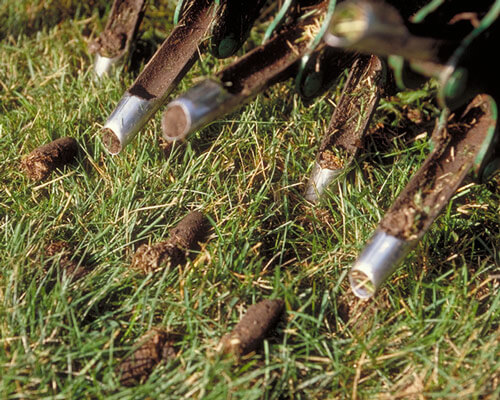
We often think fertilization is the key to a beautiful lawn, but in fact, aeration plays an extremely important role in your lawn’s health especially with the compacted clay soil we often find in the Atlanta area. Aeration is recommended at different times of the year depending on what type of grass you have, and there are a few tips to keep in mind when you decide to aerate.
Aeration Defined: Aeration is the process of mechanically punching small holes in your lawn and extracting plugs of soil. It helps the overall health of your grass, allowing for water and nutrients to reach the roots which helps the grass stand up better to the heat of summer, insects and disease.
Benefits: Aeration offers a multitude of benefits to your turf. These benefits are something fertilizer can’t achieve. In fact, aeration increases the effectiveness of fertilizers. Aeration:
- Reduces the buildup of thatch
- Helps create a 6 inch layer of top soil
- Enables efficient transport of water to the roots
- Promotes root absorption of nutrients and organic fertilizers
- Reduces soil compaction, which encourages strong root development
- Helps oxygen reach the roots so your grass can “breathe”
Good Way to Aerate: There are various ways to perform aeration, though one is more vastly used for better benefits. If you’re feeling ambitious, there are lawn aerator rental options available to complete the task, or you can give us a call and we’ll do the dirty work for you.
- Core Aeration: This is the preferable option, which uses a machine with hollow tines to extract plugs of soil. Leave the plugs on your lawn as they contain microorganisms that can help with the breakdown of thatch. Let the plugs dry out and then you can rake them and break them down.
Timing: Most lawns benefit from annual aeration and some can even use aeration twice a year. The best time to aerate is just before the grass starts to grow. Aeration is a strenuous process on your turf, so you want to make sure it will be recover quickly.
- Cool Season Grasses: Aeration and over-seeding for cool season grasses like Fescue should be preformed in September and October just before they are about to have a growth spurt.
- Warm Season Grasses: Bermuda and Zoysia should be aerated in April and May when the grass has just greened up and is about to flourish.
Other Helpful Aeration Tips:
- Give your lawn a good soaking prior to aerating. You want soft, moist soil that’s not muddy.
- Be cautious of obstacles like sprinkler lines that could be punctured during the aeration process.
- Use a crisscross pattern to ensure all areas of the lawn are evenly aerated. When completed, one square foot sample of your turf should have about 12 holes in it.
The aeration process does not use any chemicals and it enhances your turf’s natural ability to absorb nutrients and water while reducing soil compaction. It’s a win win! Aerate your lawn and let your turf take a breath of fresh air this spring.

